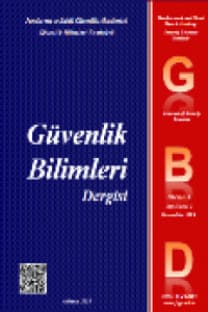TÜRKİYE’DE TERÖR OLAYLARININ HARMONİK REGRESYON ANALİZİ: PERİYODİKLİKLER VE ÖNGÖRÜ
Çalışmada, Türkiye'nin Güneydoğu bölgesindeki 2001/01-2012/11 dönemlerinde meydana gelen terör olaylarının sayısı incelenmiştir. Çalışma için Türkiye'de terör olaylarının yoğun olarak yaşandığı Güneydoğu Anadolu bölgesi seçilmiştir. Araştırmada kullanılan veriler resmi kurumlardan özel izinlerle alınmıştır. Bu çalışmada, dönem boyunca gözlenen periyodiklikler incelenerek harmonik regresyon ve klasik zaman serisi teknikleri kullanılarak anlamlı bir öngörü modeli elde edilmeye çalışılmıştır. Harmonik regresyon ve klasik zaman serileri tekniklerinin periyodik serilerin uygulanmasında daha iyi tahminler verdiği gösterilmiştir. Elde edilen sonuçlara göre, harmonik regresyon modeliyle elde edilen tahminler gerçek değerlere yakındır. Bununla birlikte, Türkiye'de terör eylemlerinin her 72 ayda (6 yıl) bir artış gösterdiği tespit edilmiş ve gözlemlenen süreklilikler yorumlanmıştır. Bu nedenle, terör örgütlerinin terörle mücadelede toparlanmalarına izin vermemek önemlidir. Bu periyodiklikleri göz önünde bulundurarak, sonuçları dünya çapında terörle ilgili birimlerle paylaşmak önemlidir.
Anahtar Kelimeler:
Harmonik Regresyon, Periyodiklik, Zaman Serileri, Terör Olayları
HARMONIC REGRESSION ANALYSIS OF TERROR EVENTS IN TURKEY: PERIODICITIES AND FORECASTING
In the study, the number of terrorist incidents occurred during 2001/01-2012/11 periods in Turkey's Southeast region are studied. Since Southeast region has the highest number of terrorist incidents in Turkey, Southeast region is selected. The data used in the study is obtained by special permission from official institutions. In this study, the periodicities observed during the period are examined and it is tried to obtain a meaningful predictive model by using harmonic regression and classical time series techniques. Harmonic regression and classical time series techniques have been shown to give better predictions in the application of periodic series. According to the results, predictions obtained by harmonic regression model are closer to the real values. However, it is determined that the acts of terrorism in Turkey show an increase in every 72 months-6 years period, and the observed periodicities are interpreted. So, it is important not to allow terrorist organizations to recover in the fight against terrorism. Considering such periodicities, it is important to share the results with the relevant units dealing with terrorism globally.
Keywords:
Harmonic Regression, Periodicities, Time Series, Terror Events,
___
- Akdi, Y. (2010). Time Series Analysis: Unit Roots and Cointegration. Gazi Bookstore. Ankara. (In Turkish).
- Alp, İ.A. (2013). The Economic Impacts of Terrorism. Journal of International Security and Terrorism. Vol.: 4 (1). (In Turkish).
- Artis, M., Clavel, J.G., Hoffmann, M. and Nachane, D. (2007). Harmonic Regression Models: A Comparative Review with Applications. Working Paper Series No. 333. Institute for Empirical Research in Economics. University of Zurich.
- Bal, A.M. (2003). Modern State and Security. IQ Culture and Art Publishing. İstanbul. (In Turkish).
- Bowie, N.G. (2017). Terrorism Events Data: An Inventory of Databases and Data Sets 1968-2017. Research Notes. Terrorism Research Initiative.
- Brockwell, P.J. and Davis, R.A. (1987). Time Series: Theory and Methods. Springer Series.
- Cordesman, G. (2017). The Patterns in Global Terrorism: 1970-2016. Center for Strategic & International Studies.
- Enders, W., Parise, G., Sandler, T. (1992). A Time-Series Analysis of Transnational Terrorism: Trends and Cycles. Defense and Peace Economics 3(4):305-320.
- Fuller, W. A. (1996). Introduction to Statistical Time Series. 2nd ed. New York: Wiley.
- Karamanoğlu, Y.E. (2016). Statistical Analysis of Terror Events: The Case of Turkey. Journal of Statisticians: Statistics and Actuarial Sciences. p.:12-25. (In Turkish).
- Katos, K.K., Liebert, H., Schulze, G. (2012). On the Heterogeneity of Terror. University of Freiburg Department of International Economic Policy Discussion Paper Series.
- Keefer, P. and Loayza, N. (2008). Terrorism, Economic Development and Political Openness. Cambridge University Press.
- Konya Chamber of Commerce (KTO). (2015). Terror, The Effects of Turkey and Regional Economics, Research Report. Economic Research and Projects Directorate. (In Turkish).
- Rusnak, D. (2010). Spatial Analysis of Terrorism, Program on Global Security.
- Sarı, G. ve Gerdan, O. (2013). Classifying Terrorist Groups by Using the Weighted Linear Programming Model, Journal of International Security and Terrorism. Vol.:4, Nu.:2. (In Turkish).
- Turkey Grand National Assembly, Human Rights Investigation Commission. (2013). Report on the Violation of the Right to Life in the Context of Terror and Violence Incidents. (In Turkish). (http://www.tbmm.gov.tr/komisyon).
- Yılmaz, B.S. ve Yılmaz, Ö.,D. (2005). Terrorism and Tourism Industry as the Goal of Terrorism. Electronic Journal of Social Sciences. Vol.:4. Nu.:13 (39-58). (In Turkish).
- Wei, W.W.S. (2006). Time Series Analysis: Univariate and Multivariate Methods. Pearson Addison Wesley.
- Weimann, G. (1988). The predictability of international terrorism: A time series analysis. Terrorism 11(6):491-502.
- ISSN: 2147-2912
- Yayın Aralığı: Yılda 2 Sayı
- Başlangıç: 2012
- Yayıncı: JANDARMA VE SAHİL GÜVENLİK AKADEMİSİ
Sayıdaki Diğer Makaleler
DEFEATING COMMUNIST INSURGENCY: THE LESSONS OF MALAYA AND VIETNAM
KATOLİKLİK-ORTODOKSLUK ÇATIŞMASI ÇERÇEVESİNDE UKRAYNA’NIN JEOPOLİTİĞİ
TERÖRİZM KAYNAKLI TEHDİTLERDE İSTİHBARAT KURUMLARININ TEHDİT DEĞERLENDİRMESİ: GELENEKSEL YAKLAŞIM
BALKANLARDA YABANCI TERÖRİST SAVAŞÇILAR
İSTİHBARATTA GÜNCEL ZORLUKLAR VE AKIMLAR
DEVLET KIRILGANLIĞI VE ÇATIŞMA SONRASI DEVLET İNŞASI: GÜNEY SUDAN ÇATIŞMASININ ANALİZİ (2013-2019)
Billy AGWANDA, Uğur Yasin ASAL
DEĞİŞEN JANDARMA TÖREN KIYAFETİNİN PERSONEL İMAJ VE AİDİYET ALGISINA ETKİSİ
MALVARLIĞINA KARŞI İŞLENEN SUÇLARIN FAİLLERİNİN SOSYAL DEĞİŞKENLER VASITASIYLA PROFİL ANALİZLERİ
COVID-19 SALGINININ TOPLUMSAL DEĞİŞİM İLE GÜVENLİK ORTAMINA ETKİSİ VE KOLLUĞA ÖNERİLER
